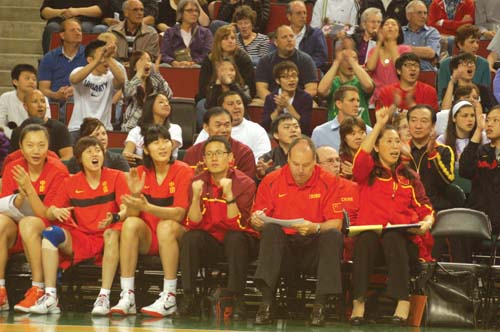
From left: Team China players with translator Tian Qile, Coach Al William Biancani, Assistant Coach Zheng Wei (Photo by Rebecca Ip/SCP)
By Assunta Ng
Rarely do I sit through a basketball game from the beginning to the end, especially when I already know the outcome. So what made me stay when the U.S. Women’s National basketball team played against the China’s Women’s National team last Saturday when the scores weren’t even close?
I reflected on the 1970s, when ping pong diplomacy was used to open up China. Last week’s basketball game gave me a new perspective on U.S.–China relations. In those days, China’s slogan was, “Friendship first, competition second.” China wasn’t in the Olympics then.

From left: Diana Taurasi (#12), Zhao Shuang (#7), Sylvia Fowles (#13), and Wei Wei (#18) (Photo by Rebecca Ip/SCP)
During the 2008 Beijing Olympics, China proved to the world that it could compete in all sports, earning a record number of medals.
We, the staff at Northwest Asian Weekly, hosted a dinner at Ocean City Restaurant welcoming the Chinese basketball team five days before the game. What I observed was that China’s motive in basketball is “learning is first, winning is second, and friendship is third.” China is aware that the U.S. team is superior.
Each time the Chinese women play against other teams, it counts as practical training for them. It is interesting to watch these games, where we can see their skills develop. Last week’s scrimmage between the China National Women’s Basketball Team and the U.S. National Women’s Basketball Team drew about 7,279 attendees. So what were the challenges for the Chinese women’s basketball team?
Vanity is a concern for female basketball players
Basketball is popular in China. Though the country has only one national women’s team, it has more than 10 men’s basketball teams. The U.S. has 12 women’s basketball teams.
Japanese Rep. Nakadake Kimiko (Photo by George Liu/NWAW)
According to the American coaches for the Chinese National Team, the Chinese female players are not as strong as American players physically. Strength is an important factor. To increase their strength, basketball players need to lift weights and train so they can run, jump, and withstand vigorous activity. However, most players are not willing to do so, fearing that bigger arms might hurt their feminine appearance. China hired an American coach last year who said that the Chinese female players’ bodies lack the muscle definition that comes from training from a young age.
During the game, I saw both Chinese and American players’ arms close up. I sat in the first row, and the players dribbled the ball as close as three feet from me. The American women’s arms are almost 50 percent bigger and firmer than those of the Chinese women. I wouldn’t want to be pushed by the American players! One touch from them and I would be down.
Who gets more money?
Do Chinese players earn more than U.S. players? Just looking at both nations’ salaries doesn’t mean much. One Chinese coach said a top-notch player can receive a salary and product endorsement deal worth as much as one million renminbi, more than $150,000. In contrast, the top U.S. basketball female player might fetch only $160,000 in addition to other expenses paid.
Unlike their male counterparts, few female players in the U.S. get commercial endorsements. Passion for the sport is an important incentive for U.S. players. U.S. players can play domestically and overseas. For example, Seattle Storm player Sue Bird was previously on the Moscow team. In contrast, Chinese female players cannot be free agents or embark on their own careers like Yao Ming.
The female players have little say about their careers as well as what they can do outside China. A guest at our welcome dinner asked the players if they were allowed to sightsee on their own in Seattle. “If they (the management) found that we were out to sightsee on our own, we [would] be in big trouble,” she replied.
Female players’ youth versus experience
Most Chinese female basketball players are chosen from all over the country, according to one coach. They are the cream of the crop, selected through many rounds of competition.
Most of them are young and in their 20s, and one of them recently got married. The U.S. team members are much older. Many of them are in their 30s, are married, and some even have kids. U.S. players like Sue Bird, Diana Taurasi, Tamika Catchings, and Sylvia Fowles have already played in their second or third Olympic game. The U.S. team has achieved four Olympic gold medals — a record — and has cumulative experience, which will be hard for China to beat.
Which team should we applaud, China or U.S.?
From the score — U.S. winning 100 to 62 — you would think China’s team is weak. The score doesn’t tell the whole story. On the contrary, China’s team is vibrant and fast. The Chinese immigrants who went to the game were proud of what the team from their motherland achieved.
One immigrant said he wanted to applaud when China scored, but he was afraid that Americans would perceive Chinese Americans as being discriminatory toward Americans. I applauded both. When the U.S. scored, I stood and clapped. When China scored, I didn’t hesitate before rising and clapping. My relative, who holds a bias for male basketball teams over female ones, said after the game, “It was a good game to watch after all.” (end)


